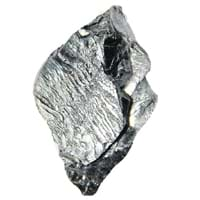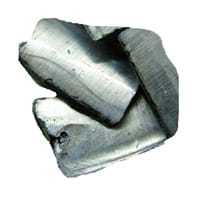Tantalum vs Potassium
Periodic Table
Symbol
Ta
K
Group Number
5
13
1
17
Period Number
6
4
Block
d block
s block
Element Family
Transition Metal
Alkali
CAS Number
7440257
99+
7440097
99+
Space Group Name
Im_ 3m
Im_ 3m
Space Group Number
229.00
1
229.00
1
Facts
Interesting Facts
- Tantalum metal is known as corrosion resistance.
- Tantalum metal can easily fabricated and It is a good conductor of heat and electricity.
- In the list of most abundant element Potassium is ranked 7th.
- Potassium can easily be sliced (chopped) down using knife.
Sources
Found in Minerals, Mining, Ores of Minerals
Found in Minerals, Mining
History
Who Discovered
Anders Gustaf Ekeberg
Humphry Davy
Discovery
In 1802
In 1807
Abundance
Abundance In Universe
8 * 10-9 %
31
3 * 10-4 %
9
Abundance In Sun
~-9999 %
~0.0004 %
9
Abundance In Meteorites
0.00 %
99+
0.07 %
9
Abundance In Earth's Crust
0.00 %
37
1.50 %
6
Abundance In Oceans
0.00 %
31
0.04 %
3
Abundance In Humans
Not Available
0.20 %
2
Uses
Uses & Benefits
- Tantalum metal is mainly used in the manufacturing of electron components. Its Oxide layer acts as an insulator.
- Tantalum metal is also used in surgical transplant like replacement of bone, skull plates and as a woven gauze.
- Potassium’s compounds are in high demand for their application in Fertilizer manufacturing.
- Potassium carbonate is used in glass manufacturing and Potassium carbonate in manufacturing detergent and body wash.
Industrial Uses
Electrical Industry, Electronic Industry
Ammunition Industry, Chemical Industry
Medical Uses
NA
Pharmaceutical Industry
Other Uses
Alloys
NA
Biological Properties
Toxicity
Low Toxic
Toxic
Present in Human Body
Yes
Yes
In Blood
Not Available
1,620.00 Blood/mg dm-3
2
In Bone
0.03 p.p.m.
28
2,100.00 p.p.m.
3
Physical Properties
Melting Point
2,996.00 °C
4
63.65 °C
99+
Boiling Point
5,425.00 °C
4
774.00 °C
99+
Appearance
Physical State
Solid
Solid
Color
Gray Blue
Silvery Gray
Luster
Metallic
NA
Hardness
Mohs Hardness
6.50
5
0.40
23
Brinell Hardness
440.00 MPa
28
0.36 MPa
99+
Vickers Hardness
870.00 MPa
12
Not Available
Speed of Sound
3,400.00 m/s
22
2,000.00 m/s
99+
Optical Properties
Reflectivity
78.00 %
6
Not Available
Allotropes
No
No
α Allotropes
Not Available
Not Available
β Allotropes
Not Available
Not Available
γ Allotropes
Not Available
Not Available
Chemical Properties
Chemical Formula
Ta
K
Isotopes
Known Isotopes
31
8
20
19
Electronegativity
Pauling Electronegativity
1.50
27
0.82
99+
Sanderson Electronegativity
Not Available
0.45
31
Allred Rochow Electronegativity
1.33
22
0.91
39
Mulliken-Jaffe Electronegativity
Not Available
0.73
23
Allen Electronegativity
1.34
33
0.73
99+
Electropositivity
Pauling Electropositivity
2.50
27
3.18
3
Ionization Energies
1st Energy Level
761.00 kJ/mol
18
418.80 kJ/mol
99+
2nd Energy Level
1,500.00 kJ/mol
40
3,052.00 kJ/mol
5
3rd Energy Level
Not Available
4,420.00 kJ/mol
8
4th Energy Level
Not Available
5,877.00 kJ/mol
9
5th Energy Level
Not Available
7,975.00 kJ/mol
8
6th Energy Level
Not Available
9,590.00 kJ/mol
13
7th Energy level
Not Available
11,343.00 kJ/mol
17
8th Energy Level
Not Available
14,944.00 kJ/mol
13
9th Energy Level
Not Available
16,963.70 kJ/mol
15
10th Energy Level
Not Available
48,610.00 kJ/mol
3
11th Energy Level
Not Available
54,490.00 kJ/mol
4
12th Energy Level
Not Available
60,730.00 kJ/mol
4
13th Energy Level
Not Available
68,950.00 kJ/mol
4
14th Energy Level
Not Available
75,900.00 kJ/mol
5
15th Energy Level
Not Available
83,080.00 kJ/mol
6
16th Energy Level
Not Available
93,400.00 kJ/mol
7
17th Energy Level
Not Available
99,710.00 kJ/mol
8
Electrochemical Equivalent
1.35 g/amp-hr
99+
1.46 g/amp-hr
99+
Electron Work Function
4.25 eV
21
2.30 eV
99+
Other Chemical Properties
Anti Corrosion, Ionization, Radioactive Isotopes, Radioactivity, Solubility
Chemical Stability, Flammability, Ionization, Solubility
Atomic Properties
Atomic Number
73
99+
19
99+
Electron Configuration
[Xe] 4f14 5d3 6s2
[Ar] 4s1
Crystal Structure
Body Centered Cubic (BCC)
Body Centered Cubic (BCC)
Crystal Lattice
BCC-Crystal-Structure-.jpg#100
BCC-Crystal-Structure-.jpg#100
Atom
Number of Protons
73
99+
19
99+
Number of Neutrons
108
28
20
99+
Number of Electrons
73
99+
19
99+
Radius of an Atom
Atomic Radius
146.00 pm
35
227.00 pm
3
Covalent Radius
170.00 pm
25
203.00 pm
9
Van der Waals Radius
200.00 pm
28
275.00 pm
5
Atomic Weight
180.95 amu
38
39.10 amu
99+
Atomic Volume
10.90 cm3/mol
99+
45.46 cm3/mol
3
Adjacent Atomic Numbers
Valence Electron Potential
110.00 (-eV)
7
10.40 (-eV)
99+
Lattice Constant
330.13 pm
99+
532.80 pm
12
Lattice Angles
π/2, π/2, π/2
π/2, π/2, π/2
Lattice C/A Ratio
Not Available
Not Available
Mechanical Properties
Density
Density At Room Temperature
16.69 g/cm3
18
0.86 g/cm3
99+
Density When Liquid (at m.p.)
15.00 g/cm3
9
0.83 g/cm3
99+
Tensile Strength
Not Available
Not Available
Viscosity
Not Available
Not Available
Vapor Pressure
Vapor Pressure at 2000 K
0.00 (Pa)
31
Not Available
Elasticity properties
Shear Modulus
69.00 GPa
13
1.30 GPa
99+
Bulk Modulus
200.00 GPa
8
3.10 GPa
99+
Young's Modulus
186.00 GPa
13
3.53 GPa
99+
Poisson Ratio
0.34
10
Not Available
Other Mechanical Properties
Ductile
NA
Magnetic Properties
Magnetic Characteristics
Specific Gravity
16.65
11
0.86
99+
Magnetic Ordering
Paramagnetic
Paramagnetic
Electrical Properties
Electrical Property
Conductor
Conductor
Resistivity
131.00 nΩ·m
25
72.00 nΩ·m
37
Electrical Conductivity
0.08 106/cm Ω
27
0.14 106/cm Ω
14
Electron Affinity
31.00 kJ/mol
29
48.40 kJ/mol
22
Thermal Properties
Specific Heat
0.14 J/(kg K)
37
0.75 J/(kg K)
6
Molar Heat Capacity
25.36 J/mol·K
99+
29.60 J/mol·K
6
Thermal Conductivity
57.50 W/m·K
27
102.50 W/m·K
15
Critical Temperature
Not Available
2,223.00 K
3
Thermal Expansion
6.30 µm/(m·K)
99+
83.30 µm/(m·K)
3
Enthalpy
Enthalpy of Vaporization
753.10 kJ/mol
2
77.50 kJ/mol
99+
Enthalpy of Fusion
31.40 kJ/mol
3
2.32 kJ/mol
99+
Enthalpy of Atomization
782.00 kJ/mol
3
89.50 kJ/mol
99+
Standard Molar Entropy
41.50 J/mol.K
37
64.70 J/mol.K
18
|
||
|
||
|












